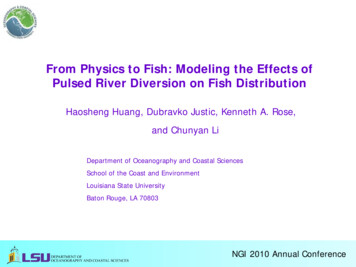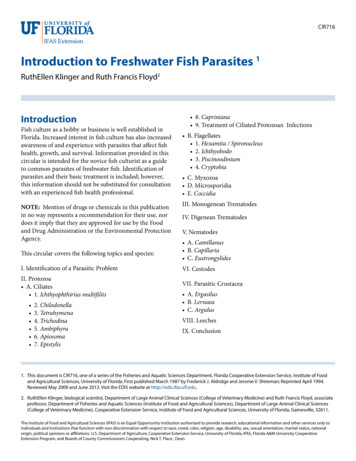
Transcription
From Physics to Fish: Modeling the Effects ofPulsed River Diversion on Fish DistributionHaosheng Huang, Dubravko Justic, Kenneth A. Rose,and Chunyan LiDepartment of Oceanography and Coastal SciencesSchool of the Coast and EnvironmentLouisiana State UniversityBaton Rouge, LA 70803NGI 2010 Annual Conference
Study AreaLouisiana Coastal WetlandsTotal of 9,881 km2 of coastalwetlands30% of total coastal marsh area90% of the coastal marsh lossWetland loss of 62 km2yr-1from 1990-2000Predicted to lose 500 km2 overthe next 50 years
Caernarvon DiversionBreton Sound EstuaryIn operation since 1991Discharge capacity is227 m3/sec (8000 cfs)Normal operation is upto 113 m3/sec.Spring 2001 pulses are227 m3/sec (8000 cfs).Mississippi RiverFrom http://www.lacoast.gov/
Pulsing diversion dischargeComparison of Caernarvon and Mississippi River DischargeThe black line is the Caernarvon discharge and the blue line is the naturalpattern of Mississippi River discharge (From http://www.lacoast.gov/)PULSES project tested the hypothesis that the reintroduction ofartificial river floods, which mimics the natural seasonal flooding ofthe river system, will restore some key natural processes, such aswetland building, and using wetlands as nutrient filter.
Hydrodynamic Condition Small diurnal tidal amplitude ( 30 cm) Meteorological forced water level variation(up to 1.0 m) Large, shallow (3 m) open water bodies Intricate network of channels and bayous Large tidal velocity in narrow passes Overland flow Floating marshes Man-made canals, channels, and structuresThe impact of Caernarvon discharge ?
Research Questions What is the flow distribution in the main channels? What is the overland flow component? How important is the river pulsing to the overall system? River pulse vs marine influence Astronomic tides vs atmospheric (frontal passage)forcing What is the impact of pulsing river diversion on waterexchange process
Numerical ModelFVCOM characteristic: Finite Volume Coastal Ocean Model Using unstructured triangular mesh Employing wet/dry point treatmentmethod Mass conservation Lagrangian particle tracking codeembedded Other featureshttp://fvcom.smast.umassd.edu
Numerical Grid
Model BathymetryData sources LIDAR Digital ElevationModel: horizontal resolution5mX5m Scanned TopographicMaps (from NOAA nauticalcharts)
Model ForcingWind speed and directionFrom NOAA National Data Buoy Center-- station GDIL1 (Grand Isle, LA)Diversion dischargeFrom USGS-- station Caernarvon Outfall Channel,LATidesFrom ADCIRC EC(East Coast)2001-- including K1, O1, Q1, M2, S2, N2
Velocity field andwetland inundationClick images to view animations.
Model Verification
Model VerificationWater levelelevationAxialvelocityStationObservationModel SimulationCorrelationCoefficientRMSEIndex ofAgreementMean(m)Std. Dev.(m)Mean(m)Std. 90StationObservationModel Simulation(m)CorrelationCoefficientRMSEIndex ofAgreementMean(m/s)Std. Dev.(m/s)Mean(m/s)Std. 0.74(m/s)
Overland flowMarch 8March 10March 1210:00 pm4:00 am9:00 amMarch 15March 202:00 am8:00 am
Water level in the channelThe influence of tidesSimulation withall forcingSimulation withouttideSimulation withtide only
Water level in the channelThe influence of diversion dischargeSimulation withall forcingSimulation withoutdiversion dischargeSimulation withdiversiondischarge only
Water level in the channelThe influence of windSimulation withall forcingSimulation withoutwindSimulation withwind only
Lagrangian particlemovement in Breton SoundClick on Images to view animation
Particle distributionSimulation with all forcingSimulation without dischargeMarch 143:00 pmMarch 143:00 pmApril 10:00 amApril 10:00 amMarch 611:00 am
Particle distributionSimulation with all forcingSimulation without dischargeMarch 143:00 pmMarch 143:00 pmApril 10:00 amApril 10:00 amMarch 611:00 am
Residence TimeSimulation with all forcing19 daysSimulation without discharge 25 days17 days 25 days 25 days16.1 days 25 days14.1 days 25 days18.7 days21.4 days9.3 days 25 days17.3 days 25 days15.7 days19.6 days9.0 days23.2 days15.8 days10.5 days21.3 days
Fish movement: Fitness Method(Railsback et al., 1999)Movement rules are designed for fish to maximize its fitness Departure rules: Fish examine potentialdestinations (X, Y, Z) every time step andmove to a location offering higher fitness ifone is available Destination rules: Fish movement is limitedby its swimming speed (determined by fishlength) and exclusion of cells where depthis zero Fitness measure: Can be determined byfood intake, mortality risk; expected survivalover a specified time horizon and expectedreproductive maturity. Simple in our initial application: salinity and food at each time stepFish location
Fish movement: Kinesis Method(Humston et al., 2004)Movement rules avoid evaluation of neighboring cells X and Y (and Z) velocities of each individual are computed hourly based onkinesis behaviorU fish w1U r w2U IV fish w1Vr w2VIwhere UI and VI are inertial velocity components (i.e., velocity from previous time step); and Ur and Vrare random velocity components. W1 and W2 are weight coefficients which are function of salinity/food.w2 H 2 exp{( 0.5)[( S S preferred ) / σ s ]2 }w1 1 H1 exp{( 0.5)[( S S preferred ) / σ s ]2 } It means that when conditions approach preferred state, fish tend to maintaintheir previous heading; while environmental conditions were not preferred,the directional persistence of fish movement is low, mimicking a random walk. In our initial application, challenges will be complicated grid and multiple cues
Summary With high-resolution bathymetric data constructed from LIDARmeasurement, FVCOM reasonably captures the hydrodynamics andwetland flooding/drying process in the Breton Sound estuary. The water level variation in the upper estuary is controlled mainly bydiversion discharge and wind, while tides and wind dominate the waterlevel oscillation in the downstream estuary. Maximum overland velocity is 10 cm/s and overland velocity followsclosely the wind direction. The river diversion tends to greatly shorten the residence time andthus enhance the flushing of the estuary, which has important ecologicalimplications. Fish modeling is ongoing
Acknowledgement Northern Gulf Institute Louisiana Sea Grant College Program LSU High Performance Computing (HPC) Louisiana Optical Network Initiative (LONI)
Pulsing diversion discharge. Comparison of Caernarvon and Mississippi River Discharge The black line is the Caernarvon discharge and the blue line is the natural











